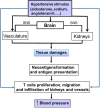New Insights on the Role of Sodium in the Physiological Regulation of Blood Pressure and Development of Hypertension
- PMID: 31608291
- PMCID: PMC6756190
- DOI: 10.3389/fcvm.2019.00136
New Insights on the Role of Sodium in the Physiological Regulation of Blood Pressure and Development of Hypertension
Abstract
A precise maintenance of sodium and fluid balance is an essential step in the regulation of blood pressure and alterations of this balance may lead to the development of hypertension. In recent years, several new advances were made in our understanding of the interaction between sodium and blood pressure regulation. The first is the discovery made possible with by new technology, such as 23Na-MRI, that sodium can be stored non-osmotically in tissues including the skin and muscles particularly when subjects are on a high sodium diet or have a reduced renal capacity to excrete sodium. These observations prompted the refinement of the original model of regulation of sodium balance from a two-compartment model comprising the extracellular fluid within the intravascular and interstitial spaces to a three-compartment model that includes the intracellular space of some tissues, most prominently the skin. In this new model, the immune system plays a role, thereby supporting many previous studies indicating that the immune system is a crucial co-contributor to the maintenance of hypertension through pro-hypertensive effects in the kidney, vasculature, and brain. Lastly, there is now evidence that sodium can affect the gut microbiome, and induce pro-inflammatory and immune responses, which might contribute to the development of salt-sensitive hypertension.
Keywords: immunity; macrophages; microbiome; muscle; skin; sweat.
Copyright © 2019 Polychronopoulou, Braconnier and Burnier.
Figures



References
LinkOut - more resources
Full Text Sources

